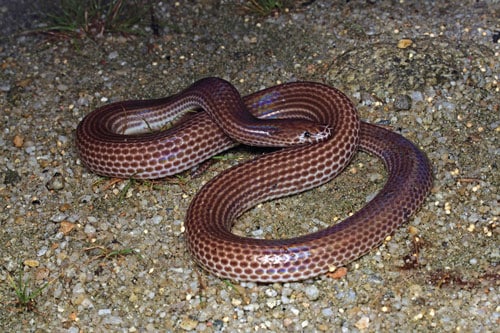Description:
Sunbeam snakes are unlike most other snakes, in that they prefer to be damp and a bit cooler. Humidity and dampness are a must for this species. For an adult sunbeam snake or two, a 40-gallon terrarium works; either a standard top-opening tank or a more naturalistic front-opening enclosure. Most important is the substrate, as sunbeam snakes like to burrow in damp dirt. I use a substrate of finely ground coconut coir mixed with peat moss to create a dirt-like substrate. One end of the enclosure should be kept very damp. The easiest way to achieve this is to place something under one end of the enclosure, to prop that end up and create a slight slant. Water will run down to the lower end and mix with the substrate to create a nice, muddy spot. The remaining substrate should be damp, but not as wet as this end, with the area at the opposite, raised end of the tank being less damp than the rest. A substrate depth of about 4 inches works well. Attach a heat pad under the enclosure at the very damp end, and set it to maintain a temperature in that end of 80 degrees Fahrenheit, with a gradient down to 70 degrees at the opposite, drier end. A humidity level of 75 percent should also be maintained. Use cork flats or similar décor placed on the substrate to provide hiding places for your sunbeam snake(s). They don’t climb much, so branches aren’t needed unless you like the way they look. You’ll need a water bowl large enough for the snakes to soak in; change it daily to keep it fresh and clean. Make sure you provide a secure top to the enclosure. It’s doubtful the snakes will climb up to make a break, but you never know. You can include lighting and additional décor if you like, but the snakes don’t need either in order to remain healthy. Sunbeam snakes do eat other snakes every so often, so don’t mix other species with them! In the wild, sunbeam snakes eat amphibians, snakes, rodents and carrion. In captivity, they can easily be switched over to frozen/thawed mice. One or two adult mice per adult snake per week works well. Use smaller prey items for smaller specimens. There are few captive-bred sunbeam snakes in the U.S., and they are rarely produced. This is a shame, as sunbeams breed fairly easily, and the babies are amazing. Most available specimens are imports from China, and they come in rough and full of parasites. Upon purchase, the first thing to do is set them up properly and have them treated by a veterinarian for worms. The snakes will also likely be covered with blisters due to improper housing at the Chinese holding area prior to being exported. Blisters can be treated with a topical antibiotic and by housing the snakes at the proper 75-percent humidity level. Once they start feeding, sunbeam snakes should do wonderfully for you, and they can make beautiful pets. Sunbeam snakes seem to be seasonally imported, so there’s either a bunch for sale or none. You can find them at specialty reptile stores, and sometimes online or at reptile shows. Sunbeam snakes make great terrarium subjects. There are some challenges in housing them, and it can be messy, but once established properly, they make great pet snakes. Sunbeam snakes handle well and rarely, if ever, bite. And they are so smooth and feel cool to the touch. I like them! The sunbeam snake is, by far, the most iridescent snake in the world. Hold one under any light, and you’ll feel like you’re holding a living rainbow. Ken Foose produced his first captive-bred snakes at age 11. With a Master’s Degree in zoology, he has been both a zookeeper and curator. He opened Exotic Pets, which specializes in reptiles and amphibians, in Las Vegas in 1991. He is currently president of the International Herpetological Symposium.
Habitat:
Damp, loose soil in areas near water
Range:
Southern China and southeast Asia
Scientific Name: Xenopeltis unicolor
Species Group:
Family: Xenopeltidae
Size:
Level: intermediate
Weight:
Dangerous: No



